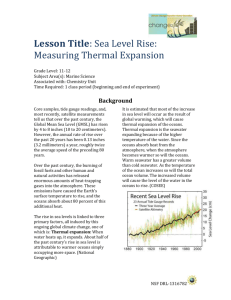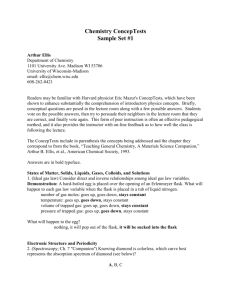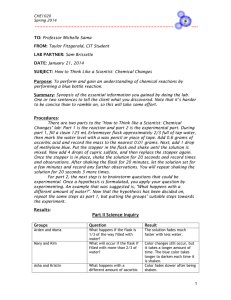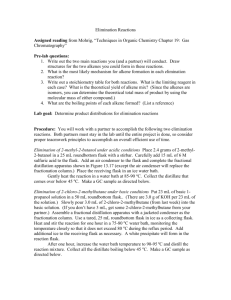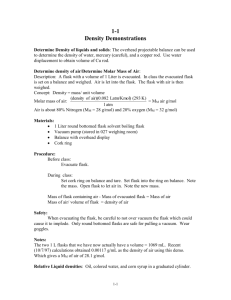Teacher Packet – Thermal Expansion Activity
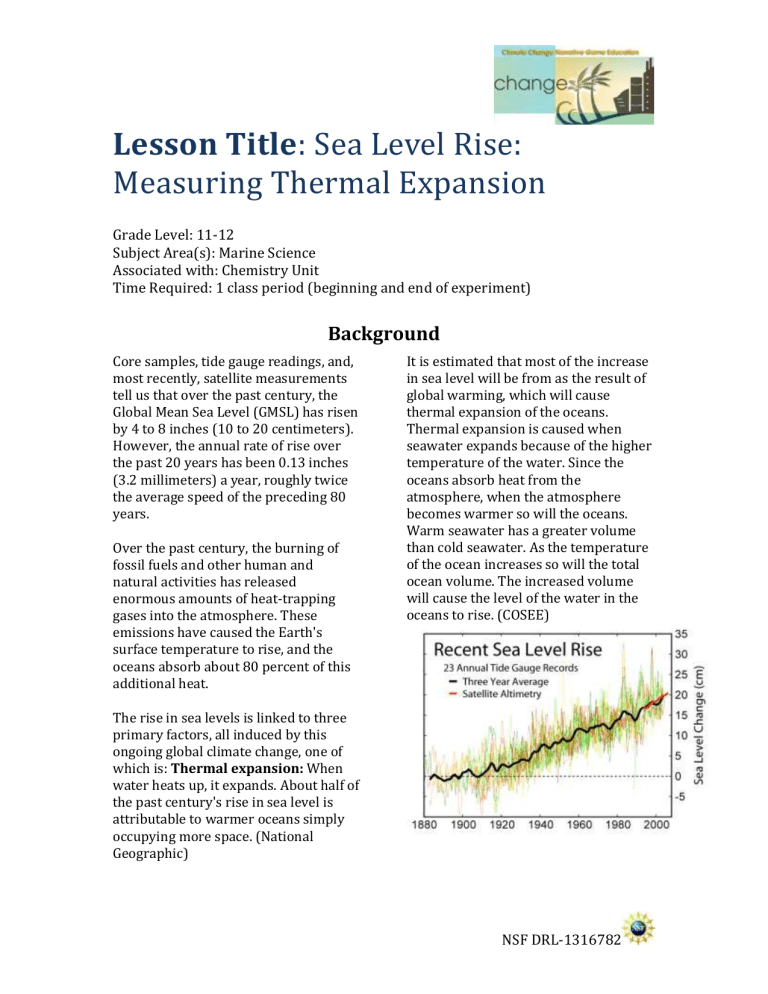
Lesson Title: Sea Level Rise:
Measuring Thermal Expansion
Grade Level: 11-12
Subject Area(s): Marine Science
Associated with: Chemistry Unit
Time Required: 1 class period (beginning and end of experiment)
Background
Core samples, tide gauge readings, and, most recently, satellite measurements tell us that over the past century, the
Global Mean Sea Level (GMSL) has risen by 4 to 8 inches (10 to 20 centimeters).
However, the annual rate of rise over the past 20 years has been 0.13 inches
(3.2 millimeters) a year, roughly twice the average speed of the preceding 80 years.
Over the past century, the burning of fossil fuels and other human and natural activities has released enormous amounts of heat-trapping gases into the atmosphere. These emissions have caused the Earth's surface temperature to rise, and the oceans absorb about 80 percent of this additional heat.
It is estimated that most of the increase in sea level will be from as the result of global warming, which will cause thermal expansion of the oceans.
Thermal expansion is caused when seawater expands because of the higher temperature of the water. Since the oceans absorb heat from the atmosphere, when the atmosphere becomes warmer so will the oceans.
Warm seawater has a greater volume than cold seawater. As the temperature of the ocean increases so will the total ocean volume. The increased volume will cause the level of the water in the oceans to rise. (COSEE)
The rise in sea levels is linked to three primary factors, all induced by this ongoing global climate change, one of which is: Thermal expansion: When water heats up, it expands. About half of the past century's rise in sea level is attributable to warmer oceans simply occupying more space. (National
Geographic)
NSF DRL-1316782
Learning Objectives:
1.
Students will be able to link thermal expansion of water in the flask to sea-level rise of our oceans.
2.
Students will be able to understand how increased water temperatures change the volume of water.
3.
Students will understand why thermal expansion is a concern for the Tampa Bay
Area.
4.
Students will be able to link human activity to sea level rise.
Materials:
Flask with long neck
Two-hole rubber stopper
Hot Plate Thermometer
Marker
Metric ruler
500ml and 10ml graduated cylinders
Marking pen
Student Record Sheet
Set-up of equipment and close-up of flask with marks made by students showing rise in water level for every 10 degree C change in temperature.
NSF DRL-1316782
Procedure:
Discuss Climate Change and Sea-Level Rise in class. Students will be performing an experiment on how thermal expansion of water contributes to sea level rise.
1.
Add water to the flask so that there is some water in its neck.
2.
Place the thermometer in the flask and be sure to take an accurate first reading.
3.
Mark the level on the glass with a marker.
4.
Make and Record your initial predictions: What do you think will happen to the water in the flask as you begin to heat it?
5.
Place the flask on the hot plate, and gradually heat the water to no more than 95 o C
6.
Make a mark on the neck of the flask each time the temperature increases by 10 o C.
7.
Let the flask cool and pour out the water.
8.
Use the ruler to measure the height of the water for each mark that you made on the flask.
9.
Use the graduated cylinders to measure the volume of water for each mark that you made on the flask.
10.
Enter your data in the data chart.
11.
Make two graphs – one of temperature vs. height, and one of temperature vs. volume.
Extension:
The graph below shows the expansion of water vs. temperature. Students can compare the shape of their graph to this one.
Students can calculate the effect of thermal expansion on the sea level. The ocean is 4000m deep. A 0.01% volume expansion will rise the sea level 4 m (0.0001*4000 m = 0.4 m).
NSF DRL-1316782
Lesson Title: Sea Level Rise: Measuring Thermal
Expansion
Initial Predictions: What are all the things that you think will happen to the water in the flask as you heat it?
_________________________________________________________________________________________________
_________________________________________________________________________________________________
_________________________________________________________________________________________________
_________________________________________________________________________________________________
Data table:
Temperature ( o C) Increase in Water Level
(mm)
Volume of water in flask
(mL)
Follow-up questions:
1) What happened to the water level in the flask as temperature increased?
_________________________________________________________________________________________________
_________________________________________________________________________________________________
_________________________________________________________________________________________________
_________________________________________________________________________________________________
2) How would you describe the relationship between the rise in temperature and the rise in the water level?
_________________________________________________________________________________________________
_________________________________________________________________________________________________
_________________________________________________________________________________________________
_________________________________________________________________________________________________
3) Why does the water level in the flask change over time?
_________________________________________________________________________________________________
_________________________________________________________________________________________________
_________________________________________________________________________________________________
_________________________________________________________________________________________________
NSF DRL-1316782
4) How do you think this is related to global warmings’ contribution to sea-level rise in our oceans?
_________________________________________________________________________________________________
_________________________________________________________________________________________________
_________________________________________________________________________________________________
_________________________________________________________________________________________________
Conclusions and Data Analysis:
1) Based on what you know about the Tampa Bay area, how could thermal expansion impact the lives of the citizens of Tampa Bay?
_________________________________________________________________________________________________
_________________________________________________________________________________________________
_________________________________________________________________________________________________
_________________________________________________________________________________________________
2) Explore this website to see if your predictions were correct: http://sealevel.climatecentral.org
How will the predicted changes in sea level affect the Tampa Bay area?
One foot? _____________________________________________________________________________________
_________________________________________________________________________________________________
_________________________________________________________________________________________________
Three feet? _____________________________________________________________________________________
_________________________________________________________________________________________________
_________________________________________________________________________________________________
Five feet? _____________________________________________________________________________________
_________________________________________________________________________________________________
_________________________________________________________________________________________________
Ten feet? _____________________________________________________________________________________
_________________________________________________________________________________________________
_________________________________________________________________________________________________
3) How can we decrease the threat of sea-level rise?
_________________________________________________________________________________________________
_________________________________________________________________________________________________
_________________________________________________________________________________________________
_________________________________________________________________________________________________
4) What actions can you take to slow the rise of sea level?
_________________________________________________________________________________________________
_________________________________________________________________________________________________
_________________________________________________________________________________________________
_________________________________________________________________________________________________
NSF DRL-1316782
5) Test your knowledge of Thermal Expansion and Sea-Level Rise: http://www.epa.gov/climatechange/students/expeditions/sea-level/index.html
Temperature ( o C)
Temperature ( o C)
NSF DRL-1316782
